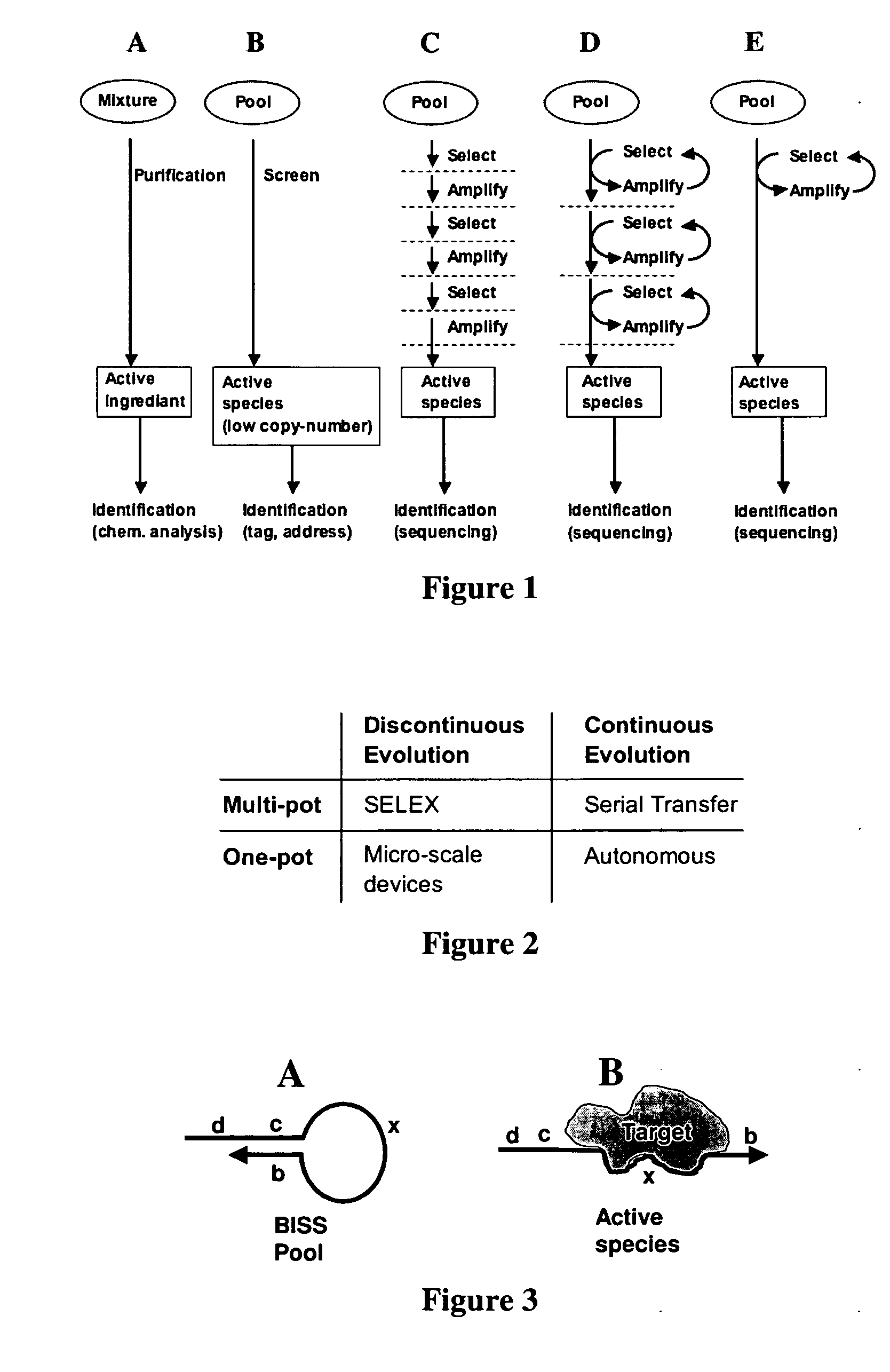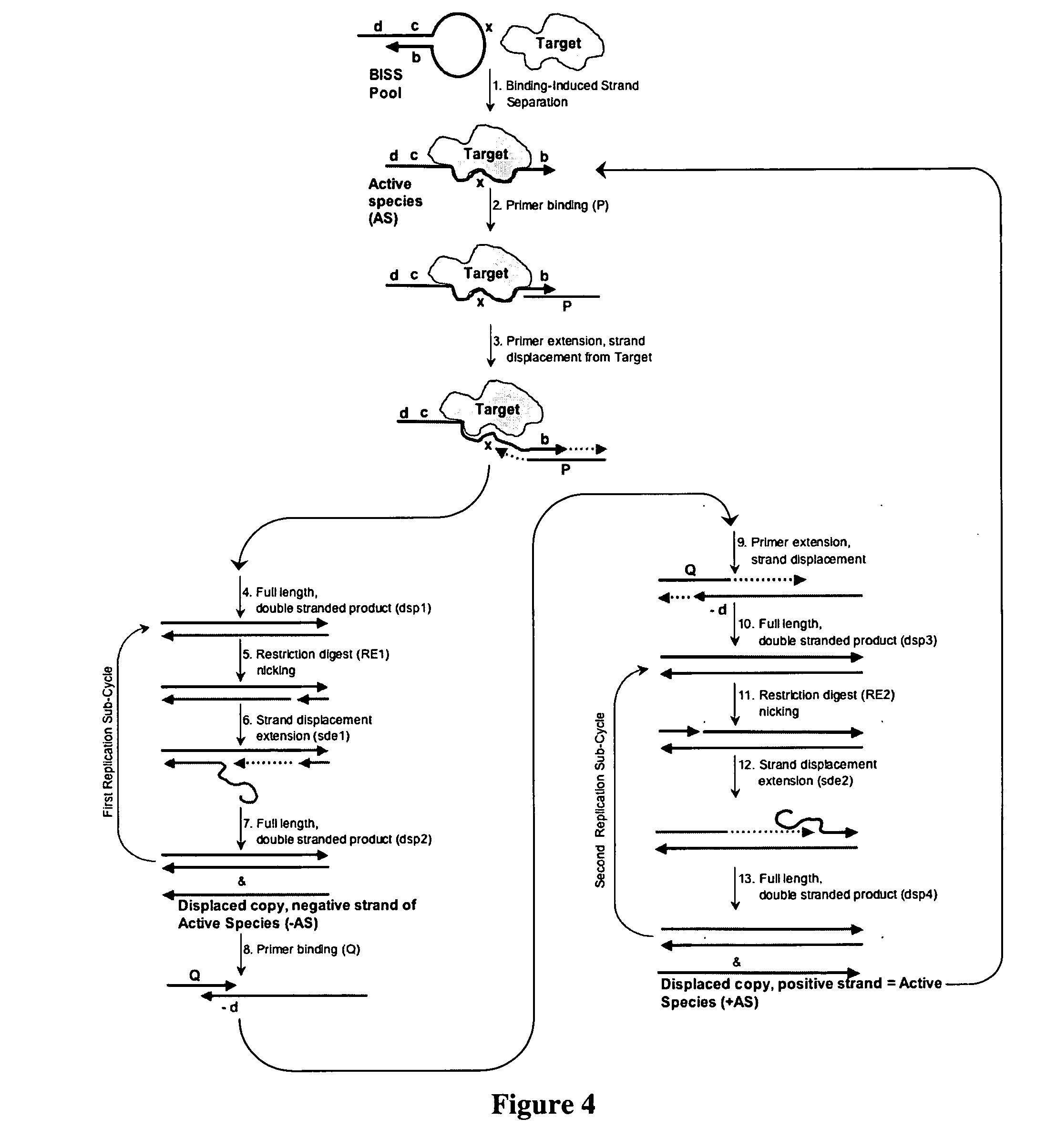Autonomous in vitro evolution
a technology of in vitro evolution and autonomous evolution, which is applied in the direction of directed macromolecular evolution, nucleotide libraries, biochemistry apparatus and processes, etc., can solve the problems of manual intervention, incompatibility of reaction conditions for each step, and limited success of these methods
- Summary
- Abstract
- Description
- Claims
- Application Information
AI Technical Summary
Benefits of technology
Problems solved by technology
Method used
Image
Examples
example 2
BISS Selection Augmented with Negative Selection
[0076]In this incarnation, the BISS-SDA autonomous evolution method of Example 1 is augmented with a negative selection system that minimizes the background amplification of inactive species that could confound the identification of desired species. In this system, the subsequence b of the BISS pool contains a modified 10-23 self-cleaving deoxyribozyme (b+m10−23), Levy, M., et al., Proc. Natl. Acad. Sci. USA (2003) 100:6416-6421, as shown in FIG. 5A. The deoxyribozyme is a variant having reduced reaction rate. Subsequence c contains within it a single-ribonucleotide linkage, acting as substrate for the 10-23 deoxyribozyme. This ribo-linkage does not interfere with primer binding or extension by polymerase. Active species will undergo SDA amplification as in Example 1 (initial primer binding of P as in FIG. 5B). Inactive species that do not bind the target, because of the continued proximity of b and c, will eventually self-cleave subse...
example 3
Self-Activation by Cleavage-Induced Topological Opening
[0077]In this embodiment, nucleotide sequences that can behave as cleavage enzymes are identified.
[0078]The generic sequence of the DNA pool is composed of the fixed subsequences a and b and the subsequence x which is the candidate. It has a fixed length but is degenerate, FIG. 6. The pool is initialized by an enzymatic ligation, preferably with a specialized ligation enzyme such as the commercially available CircLigase™ from EPICENTRE® Biotechnologies. This SASA mechanism may be termed Cleavage-Induced Topological Opening (CITO).
[0079]In the combinatorial pool, the generic form of the CITO oligonucleotide is circularized to the closed, inactive form (FIG. 6A) that becomes linearized to the open, active form (FIG. 6B) when the phosphodiester backbone linkage is cleaved at the junction of the a and b subsequences due to the activity of the successful embodiment of the degenerate sequence x. This exposes subsequence b for binding ...
example 4
Multi-Prime Amplification
[0081]As an alternative to SDA, an amplification system based on the strand propagation cascade of an isothermal, restriction enzyme-free reaction using multiple, specifically designed primers and referred to as Multi-Prime Amplification (MPA) may be used.
[0082]In MPA, the original template strand (T0) undergoes multiple cycles of template directed polymerization creating positive and negative strands (negative strands, i.e., reverse complements, are denoted by *). The synthesis of each copy is mediated by a sequential series of primer extension reactions that bind to specific 5′ and 3′ subsequences of the positive and negative copies. In FIG. 7, these subsequences are labeled as α1, α2, α3 and β1, β2, β3, for the 5′ and 3′ subsequences, respectively. The primers binding each subsequence (a unique primer for each subsequence) have tails that encode all the subsequences positioned from their binding site upstream of the direction of polymerization. These tail...
PUM
| Property | Measurement | Unit |
|---|---|---|
| Composition | aaaaa | aaaaa |
| Displacement | aaaaa | aaaaa |
Abstract
Description
Claims
Application Information
 Login to View More
Login to View More - R&D
- Intellectual Property
- Life Sciences
- Materials
- Tech Scout
- Unparalleled Data Quality
- Higher Quality Content
- 60% Fewer Hallucinations
Browse by: Latest US Patents, China's latest patents, Technical Efficacy Thesaurus, Application Domain, Technology Topic, Popular Technical Reports.
© 2025 PatSnap. All rights reserved.Legal|Privacy policy|Modern Slavery Act Transparency Statement|Sitemap|About US| Contact US: help@patsnap.com



